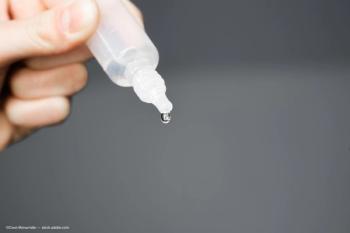
New glaucoma therapy offers first drug option in years
By Michelle Dalton, ELS;Reviewed by Jason Bacharach, MD, and Calvin Roberts, MD
When it comes to treating open-angle glaucoma, the pendulum had been swinging back towards surgical options as earlier interventions in lieu of additional medications (especially in those patients who had concurrent cataract).
However, that may all change now that the FDA approved two new medications in 2017. The first of those, latanoprostene bunod 0.024% (Vyzulta, Bausch + Lomb & Nicox), is indicated for the reduction of IOP in patients with open-angle glaucoma or ocular hypertension. The drug was approved in November 2017.
In December 2017, the FDA also approved netarsudil ophthalmic solution 0.02% (Rhopressa, Aerie Pharmaceuticals). The drug was the second new therapy approved for the lowering of elevated intraocular pressure (IOP) in patients with open-angle glaucoma or ocular hypertension.
Latanoprostene bunod works by metabolizing into two moieties: latanoprost acid, which primarily works within the uveoscleral pathway to increase aqueous humor outflow, and butanediol mononitrate, which releases nitric oxide (NO) to increase outflow through the trabecular meshwork and Schlemm's canal.
“Vyzulta will have clinical use in a variety of applications,” said Jason Bacharach, MD, North Bay Eye Associates, Petaluma, CA. Although it is not completely clear what the dual mechanisms of action mean clinically, Dr. Bacharach said he is curious to find out how the drug will work “in the mix with other medications.”
IOP-reducing option
According to the prescribing information, latanoprostene bunod begins reducing IOP within three hours after administration, and the maximum effect is achieved after 11 to 13 hours in the eye.
“This drop might be used in situations where future tolerability is a concern,” Dr. Bacharach said. “So if a patient is on a prostaglandin, such as latanoprost, is not having issues with tolerability but still needs an additional boost in IOP reduction, this might be an excellent tool.”
But clinicians “do not know how this drug works relative to other prostaglandins,” Dr. Bacharach said. “We don't know how well it works in combination with other classes of agents.”
In the VOYAGER study1, latanoprostene bunod lowered mean diurnal IOP by 1.23 mm Hg more than latanoprost 0.005% at day 28. While VOYAGER was a phase II, dose-ranging study, other large scale randomized trials have been open-label and found similar results.2
Mechanism of action
Vyzulta is “not just another IOP-lowering drug,” said Calvin Roberts, MD, chief medical officer, Bausch + Lomb.
IOP elevation occurs as the result of decreased aqueous outflow through the trabecular meshwork. Other drugs on the market “use a different mechanism of action to lower IOP other than via the conventional pathway,” Dr. Roberts said. Latanoprostene bunod targets the trabecular meshwork with the addition of the NO component.
Latanoprostene bunod cleaves into latanoprost acid and butanediol mononitrate (an NO-donating moiety) when exposed to ubiquitous esterases in the ocular environment.1
“NO increases outflows through the trabecular meshwork and Schlemm's canal,” Dr. Roberts said. “That what's really, really different (about Vyzulta). Rather than compensate with a different mechanism of action, Vyzulta uses the conventional outflow mechanism.”
NO is a naturally occurring substance that is often used as a mediator throughout the body, Dr. Roberts added.
“Studies have shown that patients with elevated IOP have decreased levels of NO in the aqueous,” he said. Researchers at Nicox (which originally developed the compound and licensed it to B+L) identified a means to provide NO to restore the inbalance.
Dr. Roberts is “excited to get feedback from glaucoma specialists once they've had the opportunity in a real world setting to use this on patients.”
Road to approval
The prescribing information cites data from clinical studies with up to 12 months duration, in which patients with an average baseline IOP of 26.7 mm Hg were able to achieve IOP-lowering effects of up to 7 mm Hg to 9 mm Hg with once-daily dosing.
The phase III pivotal studies showed a statistical superiority of latanoprostene bunod to timolol, with a similar safety profile to existing prostaglandin analogues at 3 months.
Before glaucoma medications are approved in the United States, they must first show non-inferiority before they can show superiority, Dr. Bacharach said.
“That’s not an easy bar to jump,” Dr. Bacharach explained. “From an efficacy standpoint, Vyzulta appears to be excellent, and what differentiates that improvement in IOP reduction over two of our most commonly used agents is the fact that it combines that efficacy with excellent tolerability.”
Long-term results were equally impressive, Dr. Bacharach added.
JUPITER study2 evaluated 121 Japanese subjects with a baseline IOP of 19.6 mm Hg in the study eye and reported a mean IOP reduction in the treated eye of 22% by week 4 that was maintained through week 52. However, at week 52, 9% of treated eyes had an increase in iris pigmentation and the most common adverse events were conjunctival hyperemia, growth of eyelashes, eye irritation, and eye pain.
Changing glaucoma landscape
Glaucoma specialists have been clamoring for new treatment options for years.
“Open-angle glaucoma is an incurable disease and invariably patients need adjustments, and Vyzulta is probably going to be another excellent tool for us to have in our tool chest,” Dr. Bacharach said.
How will latanoprostene bunod stack up in the market remains to be seen-there have been no head-to-head clinical studies against other newly approved therapies.
References
1. Weinreb RN, Ong T, Scassellati Sforzolini B, et al. A randomized, controlled comparison of latanoprostene bunod and latanoprost 0.005% in the treatment of ocular hypertension and open angle glaucoma: the VOYAGER study. Br J Ophthalmol 2015;99:738–745.
2. Kawase K, Vittitow JL, Weinreb RN, Araie M, Group JS. Long-term Safety and Efficacy of Latanoprostene Bunod 0.024% in Japanese Subjects with Open-Angle Glaucoma or Ocular Hypertension: The JUPITER Study. Adv Ther 2016;33:1612-1627.
Newsletter
Don’t miss out—get Ophthalmology Times updates on the latest clinical advancements and expert interviews, straight to your inbox.













































